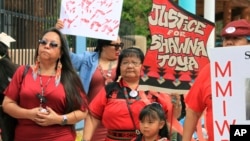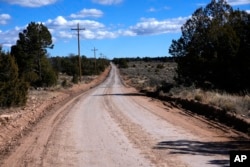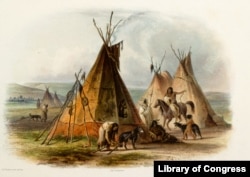Native Americans
Native American News Roundup, April 21-27, 2024

US House committee chair stresses tribal sovereignty
Oklahoma congressman Tom Cole is the first Native American to chair the powerful U.S. House Appropriations Committee, which passes bills to fund the federal government.
In a message to constituents Monday, Cole, a citizen of the Chickasaw Nation of Oklahoma said, "It is important to remember that Native Americans are the First Americans. They are sovereign nations who governed themselves long before settlers arrived, and they continue to do so today.
"Through legally binding agreements, such as the federal trust responsibility, the United States is obligated to provide services and federal resources to tribes — a responsibility I have been and will continue to work to ensure is met," Cole wrote.
He also stressed the importance of raising congressional awareness about Native American issues, sovereign rights and the unique challenges facing tribal communities.
Read more:
Native Americans most likely victims of deadly police force
A Lee Enterprises' Public Service Journalism team has published the first of a series of stories from more than a year's research into why Native Americans are more likely than any other racial group to die in the hands of law enforcement.
The opening article focuses on South Dakota, home to nine federally recognized tribes, and cites poor funding for police in tribal communities and a lack of accountability for fatal law enforcement incidents. Their investigation also found that loved ones of Native Americans who die in jail or police shootings "struggle to access even the most basic information about how these deaths occur."
According to figures compiled by the Indigenous-led activist and advocacy group NDN Collective, Native Americans represent 8.2% of the South Dakota population but were victims in 75% of fatal police shootings from 2001 to 2023.
In its 2021 report to Congress, the Interior Department's Bureau of Indian Affairs said that its Public Safety and Justice Programs across Indian Country are funded at just under 13% of total need and that it would take an additional 25,655 new officers to adequately serve Indian Country.
As VOA has previously reported, South Dakota governor Kristi Noem has repeatedly criticized the Biden administration for failing to adequately fund tribal law enforcement.
Inadequate funding of tribal safety and justice programs is not a new problem. In July 2003, the U.S. Civil Rights Commission reported that per capita spending on law enforcement in Native American communities was about 60% of the national average.
Read more:
Navajo Nation to investigate abuse allegations
Navajo Nation President Buu Nygren says he welcomes an independent, fair and transparent investigation into allegations of sexual harassment and sexual assault within the office of the tribal president and vice president.
In a Facebook stream April 16, Vice President Richelle Montoya revealed that she was sexually harassed within the office of the president and vice president during an August 2023 staff meeting.
"I was made to feel that I had no power to leave the room, I was made to feel that what I was trying to accomplish didn't mean anything, that I was less than," she said.
She did not name the individual who harassed her, "for fear of retaliation."
In November 2023, Navajo Times reported that former employees had experienced sexual assault and sexual harassment in the same office.
Indigenous journalists call for greater representation in media
The president of the Indigenous Journalists Association, or IJA, this week called on the United Nations Permanent Forum on Indigenous Issues to better support Indigenous journalism
"Globally, Indigenous communities are ignored, misrepresented, maligned and in many cases dehumanized by media portrayals of our cultures, distinct issues and the challenges we face due to the impacts of colonization," said IJA head Christine Trudeau, a citizen of the Prairie Band Potawatomi Nation.
Fewer than half of 1% of newsroom employees identify as Indigenous, she said, adding that some of the most prestigious news outlets routinely stereotype — or disregard altogether — tribal nations.
"To fully realize self-determination, we must ensure that our cultures are accurately represented in the coverage of our communities," she said.
See Trudeau's full statement in the video above.
Feds return land to tribe in Illinois
One hundred seventy-five years ago, Shab-eh-nay ("Built Like a Bear"), chief of the Prairie Band Potawatomi in Illinois, returned home from an extended visit to Kansas to find that the U.S. government had illegally auctioned off more than 1,200 acres (485 hectares) of land promised under the Prairie du Chien treaty of 1829.
Late last week, the Interior Department announced it would place 130 acres (52 hectares) of the original Shab-ey-nay Reservation land into trust for the Prairie Band Potawatomi Nation, which is now the only federally recognized tribal nation in Illinois.
Read more:
North Carolina tribe opens medical cannabis dispensary
The Eastern Band of Cherokee, or EBCI, has opened the first cannabis dispensary in the state of North Carolina. The Great Smoky Cannabis Company opened on April 20, known for decades as the national cannabis holiday "4-20."
Marijuana is still illegal in North Carolina, but because the EBCI is a federally recognized sovereign nation, it can make its own laws. The tribe legalized medical marijuana in 2021 and voted to legalize recreational cannabis in September 2023.
North Carolina residents at least 21 years old can apply for a medical card from the EBCI cannabis control board. They will need to demonstrate they have one of 18 medical conditions that include anxiety, PTSD and cancer.
Read more:
See all News Updates of the Day
Native American news roundup May 5-11, 2024
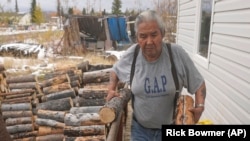
Senators look to improve services for Indigenous elders
U.S. Senators Lisa Murkowski (R-Alaska) and Tina Smith (D-Minnesota) have introduced legislation to improve federal programs and services for Alaska Native, American Indian, and Native Hawaiian elders and allow them to age in their home communities.
The Enhancing Native Elders’ Longevity, Dignity, Empowerment, and Respect (Native ELDER) Act would set up an advisory committee to improve OAA services to Native American elders, who already face worse health outcomes compared to other senior citizens.
“When meeting with Alaska stakeholders, they identified home modifications to improve accessibility and caregiver support as some of the greatest unmet needs for Alaska Native Elders,” Murkowski said.
Smith said that giving elders the tools to age comfortably and with dignity in their own homes will help keep tribal communities strong.
“I’m proud this bill will help to deliver on that promise,” she added.
Read more:
Feds fail to respond to syphilis crisis among Great Plains tribes
The U.S. Health and Human Services Department had failed to respond to urgent calls from Great Plains tribes about alarming rates of syphilis cases among Native Americans in the region, according to the nonprofit digital newsroom ProPublica.
The statistics are alarming: In 2023, three percent of all Native American babies born in South Dakota were infected, and the syphilis rate among Indigenous peoples of the Great Plains is higher than any recorded rate in the U.S. since 1941, the year doctors discovered the infection could be treated with penicillin.
In February, the Great Plains Tribal Leaders’ Health Board called on HHS Secretary Xavier Becerra to declare a state of emergency, to send in Public Health Services officers to help diagnose and treat cases, and to fund tribal efforts to better respond to the crisis.
So far, Becerra has not responded, but an HHS spokesperson told ProPublica that the department has received the request and will “respond directly.”
Read more:
South Dakota governor now banned from five Indian reservations
This week, the Sisseton-Wahpeton Oyate, or SWO, became the fifth Native American tribe in South Dakota to ban Governor Kristi Noem from Trust Lands of the Lake Traverse Reservation until such time that she issues a formal and public apology.
The resolution, passed Tuesday, says Noem has “made statements and undertaken actions that have been injurious toward the parents of tribal children, thus detracting from the value of their education.”
It also accuses Noem of “undermining the Tribal Council’s efforts to combat the drug epidemic.”
During a town hall meeting on March 13, Noem said she believes tribal leaders are 'personally benefiting' from drug cartels and that tribal children 'don’t have parents who show up and help them.'
To date, five tribes have banned Noem from about 17 percent of land in the state.
Dakota News Now reports that other tribes are considering similar bans.
Read more:
NARF: Indigenous students deserve both recognition and religion
Growing numbers of Native American students are stepping up to assert their rights to wear feathers, leis and other cultural regalia during graduation ceremonies. While many schools across the country allow the practice, some school districts hold out, saying it violates dress codes.
The Native American Rights Fund, or NARF, has developed a pair of flyers to help students and schools navigate the issue. One flyer is designed to help students responsibly advocate for changes in school policy.
A second flyer aims to help school districts understand the cultural and religious significance of wearing eagle feathers.
“The U.S. Constitution’s Free Exercise Clause protects religious practices and recognize[s] the exercise of religion as an unalienable right,” NARF states on its website. “Wearing an eagle feather or regalia to show academic success and religious beliefs should be considered protected practices.”
Read more:
Tribes, advocacy group, fight Montana TikTok ban
The Confederated Salish and Kootenai Tribes, or CSKT, and the National Congress of American Indians, or NCAI, have joined in the fight against Montana’s 2023 TikTok ban on grounds that it violates tribal sovereignty.
In April 2023, Montana became the first U.S. state to ban TikTok on all personal devices operating inside the state. It cited concerns that TikTok, owned by the Chinese tech firm Bytedance, could use the platform to harvest user data and share it with the Chinese Communist Party.
In November 2023, a federal judge temporarily blocked the ban as a violation of free speech rights. NCAI and the CSKT, along with other free speech and internet freedom advocacy groups, are now urging a federal appeals court to uphold the lower court’s decision.
In an amicus brief filed Tuesday, they argued that the ban infringes on tribal sovereignty including tribes' digital sovereignty.
Read more:
D-Day veteran spreads message of peace ahead of 80th anniversary

On D-Day, Charles Shay was a 19-year-old U.S. Army medic who was ready to give his life — and save as many as he could.
Now 99, he's spreading a message of peace with tireless dedication as he's about to take part in the 80th anniversary commemorations of the landings in Normandy that led to the liberation of France and Europe from Nazi Germany occupation.
"I guess I was prepared to give my life if I had to. Fortunately, I did not have to," Shay said in an interview with The Associated Press.
A Penobscot tribe citizen from Indian Island in the U.S. state of Maine, Shay has been living in France since 2018, not far from the shores of Normandy where many world leaders are expected to come next month. Solemn ceremonies will be honoring the nearly 160,000 troops from Britain, the U.S., Canada and other nations who landed on June 6, 1944.
Nothing could have prepared Shay for what happened that morning on Omaha Beach: bleeding soldiers, body parts and corpses strewn around him, machine-gun fire and shells filling the air.
"I had been given a job, and the way I looked at it, it was up to me to complete my job," he recalled. "I did not have time to worry about my situation of being there and perhaps losing my life. There was no time for this."
Shay was awarded the Silver Star for repeatedly plunging into the sea and carrying critically wounded soldiers to relative safety, saving them from drowning. He also received France's highest award, the Legion of Honor, in 2007.
Still, Shay could not save his good friend, Pvt. Edward Morozewicz. The sad memory remains vivid in his mind as he describes seeing his 22-year-old comrade lying on the beach with a serious stomach wound.
"He had a wound that I could not help him with because I did not have the proper instruments ... He was bleeding to death. And I knew that he was dying. I tried to comfort him. And I tried to do what I could for him, but there was no help," he said. "And while I was treating him, he died in my arms."
"I lost many close friends," he added.
A total of 4,414 Allied troops were killed on D-Day itself, including 2,501 Americans. More than 5,000 were wounded.
Shay survived. At night, exhausted, he eventually fell asleep in a grove above the beach.
"When I woke up in the morning. It was like I was sleeping in a graveyard because there were dead Americans and Germans surrounding me," he recalled. "I stayed there for not very long and I continued on my way."
Shay then pursued his mission in Normandy for several weeks, rescuing those wounded, before heading with American troops to eastern France and Germany, where he was taken prisoner in March 1945 and liberated a few weeks later.
After World War II, Shay reenlisted in the military because the situation of Native Americans in his home state of Maine was too precarious due to poverty and discrimination.
"I tried to cope with the situation of not having enough work or not being able to help support my mother and father. Well, there was just no chance for young American Indian boys to gain proper labor and earn a good job," he said.
Maine would not allow individuals living on Native American reservations to vote until 1954.
Shay continued to witness history — returning to combat as a medic during the Korean War, participating in U.S. nuclear testing in the Marshall Islands and later working at the International Atomic Energy Agency in Vienna, Austria.
For over 60 years, he did not talk about his WWII experience.
But he began attending D-Day commemorations in 2007 and in recent years, he has seized many occasions to give his powerful testimony. A book about his life, "Spirits are guiding" by author Marie-Pascale Legrand, is about to be released this month.
In 2018, he moved from Maine to Bretteville-l'Orgueilleuse, a French small town in the Normandy region to stay at a friend's home.
During the COVID-19 pandemic in 2020-21, coming from his nearby home, he was among the few veterans able to attend commemorations. He stood up for all others who could not make the trip amid restrictions.
Shay also used to lead a Native American ritual each year on D-Day, burning sage in homage to those who died. In 2022, he handed over the remembrance task to another Native American, Julia Kelly, a Gulf War veteran from the Crow tribe, who since has performed the ritual in his presence.
The Charles Shay Memorial on Omaha Beach pays tribute to the 175 Native Americans who landed there on D-Day.
Often, Shay expressed his sadness at seeing wars still waging in the world and what he considers the senseless loss of lives.
Shay said he had hoped D-Day would bring global peace. "But it has not, because you see that we go from one war to the next. There will always be wars. People and nations cannot get along with each other."
As US spotlights those missing or dead in Native communities, prosecutors work to solve their cases
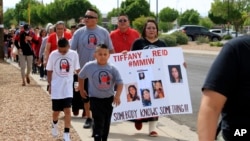
It was a frigid winter morning when authorities found a Native American man dead on a remote gravel road in western New Mexico. He was lying on his side, with only one sock on, his clothes gone and his shoes tossed in the snow.
There were trails of blood on both sides of his body and it appeared he had been struck in the head.
Investigators retraced the man's steps, gathering security camera footage that showed him walking near a convenience store miles away in Gallup, an economic hub in an otherwise rural area bordered on one side by the Navajo Nation and Zuni Pueblo on the other.
Court records said the footage and cell phone records showed the victim — a Navajo man identified only as John Doe — was "on a collision course" with the man who would ultimately be accused of killing him.
A grand jury has indicted a man from Zuni Pueblo on a charge of second-degree murder in the Jan. 18 death, and prosecutors say more charges are likely as he is the prime suspect in a series of crimes targeting Native American men in Gallup, Zuni and Albuquerque. Investigators found several wallets, cell phones and clothing belonging to other men when searching his vehicle and two residences.
As people gathered around the nation on Sunday to spotlight the troubling number of disappearances and killings in Indian Country, authorities say the New Mexico case represents the kind of work the U.S. Department of Justice had aspired to when establishing its Missing and Murdered Indigenous Persons outreach program last summer.
Special teams of assistant U.S. attorneys and coordinators have been tasked with focusing on MMIP cases. Their goal: Improve communication and coordination across federal, tribal, state and local jurisdictions in hopes of bridging the gaps that have made solving violent crimes in Indian Country a generational challenge.
Some of the new federal prosecutors were participating in MMIP Awareness Day events. From the Arizona state capitol to a cultural center in Albuquerque and the Qualla Boundary in North Carolina, marches, symposiums, art exhibitions and candlelight vigils were planned for May 5, which is the birthday of Hanna Harris, who was only 21 when she was killed on the Northern Cheyenne Indian Reservation in Montana in 2013.
It was an emotional day in Albuquerque, where family members and advocates participated in a prayer walk. They chanted: "What do we want? Answers! What do we want? Justice!" There were tears and long embraces as they shared their stories and frustrations. They talked about feeling forgotten and the lack of resources in Native communities.
Geraldine Toya of Jemez Pueblo marched with other family members to bring awareness to the death of her daughter Shawna Toya in 2021. She said she and her husband are artists who make pottery and never dreamed they would end up being investigators in an effort to determine what happened to their daughter.
"Our journey has been rough, but you know what, we're going to make this journey successful for all of our people that are here in this same thing that we're struggling through right now," she said, vowing to support other families through their heartbreak as they seek justice.
Alex Uballez, the U.S. attorney for the District of New Mexico, told The Associated Press on Friday that the outreach program is starting to pay dividends.
"Providing those bridges between those agencies is critical to seeing the patterns that affect all of our communities," Uballez said. "None of our borders that we have drawn prevents the spillover of impacts on communities — across tribal communities, across states, across the nation, across international borders."
Assistant U.S. Attorney Eliot Neal oversees MMIP cases for a region spanning New Mexico, Arizona, Colorado, Utah and Nevada.
Having law enforcement agencies and attorneys talking to each other can help head off other crimes that are often precursors to deadly violence. The other pieces of the puzzle are building relationships with Native American communities and making the justice system more accessible to the public, Neal said.
Part of Neal's work includes reviewing old cases: time-consuming work that can involve tracking down witnesses and resubmitting evidence for testing.
"We're trying to flip that script a little bit and give those cases the time and attention they deserve," he said, adding that communicating with family members about the process is a critical component for the MMIP attorneys and coordinators.
The DOJ over the past year also has awarded $268 million in grants to tribal justice systems for handling child abuse cases, combating domestic and sexual violence and bolstering victim services.
Assistant U.S. Attorney Bree Black Horse was dressed in red as she was sworn in Thursday during a ceremony in Yakima, Washington. The color is synonymous with raising awareness about the disproportionate number of Indigenous people who have been victims of violence.
She prosecutes MMIP cases in a five-state region across California and the Pacific Northwest to Montana. Her caseload is in the double digits, and she's working with advocacy groups to identify more unresolved cases and open lines of communication with law enforcement.
An enrolled member of the Seminole Nation of Oklahoma and a lawyer for more than a decade, Black Horse said having 10 assistant U.S. attorneys and coordinators focusing solely on MMIP cases is unprecedented.
"This is an issue that has touched not only my community but my friends and my family," she said. "I see this as a way to help make sure that our future generations, our young people don't experience these same kinds of disparities and this same kind of trauma."
In New Mexico, Uballez acknowledged the federal government moves slowly and credited tribal communities with raising their voices, consistently showing up to protest and putting pressure on politicians to improve public safety in tribal communities.
Still, he and Neal said it will take a paradigm shift to undo the public perception that nothing is being done.
The man charged in the New Mexico case, Labar Tsethlikai, appeared in court Wednesday and pleaded not guilty while standing shackled next to his public defender. A victim advocate from Uballez's office was there, too, sitting with victims' family members.
Tsethlikai's attorney argued that evidence had yet to be presented tying her client to the alleged crimes spelled out in court documents. Assistant U.S. Attorney Matthew McGinley argued that no conditions of release would keep the community safe, pointing to cell phone data and DNA evidence allegedly showing Tsethlikai had preyed on people who were homeless or in need of alcohol so he could satisfy his sexual desires.
Tsethlikai will remain in custody pending trial as authorities continue to investigate. Court documents list at least 10 other victims along with five newly identified potential victims. McGinley said prosecutors wanted to focus on a few of the cases "to get him off the street" and prevent more violence.
Native American News Roundup April 28 - May 4, 2024
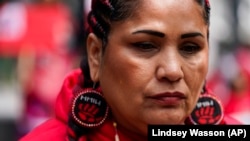
Communities to commemorate Indigenous missing and murdered
Sunday, May 5, is Missing or Murdered Indigenous Persons Awareness Day in the U.S., a date set aside to raise awareness about an epidemic of violence and violent crimes in Native and Indigenous communities.
Communities across the U.S. are marking the day with gatherings, marches and workshops.
Native and First Nations communities in the U.S. and Canada say authorities often fail to investigate these cases, and the lack of closure inflicts despair on tribal communities.
Under the Biden administration, federal agencies have been ordered to enhance public safety and criminal justice for Native Americans. This includes the establishment of a Missing & Murdered Unit within the Bureau of Indian Affairs Office of Justice Services.
Read more:
Thousands of Native American families may lose Internet access
This month, the U.S. Internet affordability program will run out of funds, and unless Congress provides additional plans, more than 23 million low-income families will be forced to pay for more expensive service plans or do without the internet altogether.
Native Americans on rural reservations may be hardest hit, CNN reported this week. About 329,500 tribal households are currently enrolled in the program, with the majority of those concentrated in Oklahoma, Arizona, New Mexico, Alaska and South Dakota.
The White House, the Federal Communications Commissions and digital equity advocacy groups are urging Congress to pass the bipartisan ACP Extension Act, which would allocate an additional $7 billion to keep the program running until the end of the year.
In 2021, Congress passed the $1.2 trillion Bipartisan Infrastructure Deal, which allocated more than $14 billion to help low-income families afford high speed Internet. It has offered eligible households a discount of up to $30 per month toward Internet service and up to $75 per month for households on tribal lands. Households also received one-time discounts on the purchasing of laptops, desktop computers or tablets.
Read more:
Navajo resolve to ban uranium hauling on reservation
Navajo President Buu Nygren on April 29 signed a resolution urging President Joe Biden to halt uranium hauling on Navajo lands.
The legislation, supported by the Navajo Nation Council, underscores the lasting devastation caused by past uranium mining and calls for executive action to prevent further harm to land, water and public health.
"The transportation of uranium ore across Navajo Nation lands represents a disregard for Navajo Nation law, threatens its territorial integrity and is a threat to the sovereignty of the Navajo Nation," the resolution reads. "The need to halt plans to transport uranium across Navajo Nation lands is a pressing public need which requires final action by the Navajo Nation Council."
According to the Navajo Nation's Radioactive and Related Substances Equipment, Vehicles, Persons and Materials Transportation Act of 2012, the transportation of uranium within the Navajo Nation is prohibited. However, a provision in the law exempts the transportation of uranium along state and federal highways that cross the reservation.
"We are unwavering in our stance against uranium," Nygren said Monday. "This legislation is a product of the dedication of our legislative and executive bodies of government. Today, united, we are sending a powerful message to Washington, D.C."
Indigenous students mocked at ND high school prom
A North Dakota high school has apologized after a group of white high school students were caught on video mocking traditional powwow dancing during their annual prom dance on April 20.
A number of Native American students from the Standing Rock Sioux Tribe captured videos of the incident at the Flasher High School dance. The mother of one of the Indigenous students posted some of them on Facebook.
"At no time was there any intentional intent to disrespect the Native American culture," Flasher Public School superintendent Jerry Erdahl posted on Facebook. "To the Native American people, we are sincerely apologetic. Now, for us here at Flasher Public School, is the time to educate both students and staff on cultural sensitivity issues that can affect values, morals and beliefs of others."
Read more:
Lakota reaction to SD governor's upcoming memoir
South Dakota Republican Governor Kristi Noem continued to face backlash this week in the wake of revelations that she shot and killed a rambunctious 14-month-old puppy because he was "less than worthless … as a hunting dog." The same day, she also killed a male goat because he smelled "disgusting."
Oliver Semans, a Sicangu Lakota citizen from the Rosebud Reservation, told VOA that people are upset.
"You know, dogs are sacred to the Lakota people. Súŋka wakan, sacred dog. Before the horse, it was the dogs that used to take and carry our teepee poles and other things. And when we got the horses, the horses were called wakan, sacred."
The Guardian newspaper broke the story April 26 after getting an advance copy of a forthcoming book in which Noem described the incident as an example of her willingness to do anything "difficult, messy and ugly."
Noem has defended her actions, characterizing the dog as a "working dog, not a puppy" and saying she chose to protect her family.










